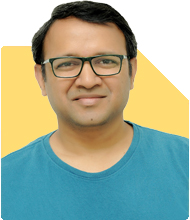Radheshyam Zanwar |5872 Answers |Ask -Follow
MHT-CET, IIT-JEE, NEET-UG Expert - Answered on Jun 07, 2025
Based in Aurangabad, Maharashtra, it provides coaching for Class 10 and Class 12 students as well.
Since the last 25 years, Radheshyam has been teaching mathematics to Class 11 and Class 12 students and coaching them for engineering and medical entrance examinations.
Radheshyam completed his civil engineering from the Government Engineering College in Aurangabad.... more

I am getting iiit allahabad IT and ece in nit Trichy, so I should go with iiit allahbad it according to your advice right?
You may like to see similar questions and answers below
Nayagam P P |9494 Answers |Ask -Follow
Career Counsellor - Answered on Jun 08, 2024
Radheshyam Zanwar |5872 Answers |Ask -Follow
MHT-CET, IIT-JEE, NEET-UG Expert - Answered on Jun 06, 2025
Radheshyam Zanwar |5872 Answers |Ask -Follow
MHT-CET, IIT-JEE, NEET-UG Expert - Answered on Jun 06, 2025
Dr Dipankar Dutta |1783 Answers |Ask -Follow
Tech Careers and Skill Development Expert - Answered on Jul 28, 2025
Dr Dipankar Dutta |1783 Answers |Ask -Follow
Tech Careers and Skill Development Expert - Answered on Jul 28, 2025
Dr Dipankar Dutta |1783 Answers |Ask -Follow
Tech Careers and Skill Development Expert - Answered on Jul 28, 2025
Dr Dipankar Dutta |1783 Answers |Ask -Follow
Tech Careers and Skill Development Expert - Answered on Jul 28, 2025
Dr Dipankar Dutta |1783 Answers |Ask -Follow
Tech Careers and Skill Development Expert - Answered on Jul 28, 2025
Dr Dipankar Dutta |1783 Answers |Ask -Follow
Tech Careers and Skill Development Expert - Answered on Jul 28, 2025
Dr Dipankar Dutta |1783 Answers |Ask -Follow
Tech Careers and Skill Development Expert - Answered on Jul 28, 2025
Patrick Dsouza |1336 Answers |Ask -Follow
CAT, XAT, CMAT, CET Expert - Answered on Jul 27, 2025
Patrick Dsouza |1336 Answers |Ask -Follow
CAT, XAT, CMAT, CET Expert - Answered on Jul 27, 2025
Nayagam P P |9494 Answers |Ask -Follow
Career Counsellor - Answered on Jul 27, 2025

















